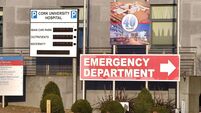Ambulance delays in Cork ‘highly concerning’

An ambulance outside the emergency department at CUH. File image. Picture Denis Minihane.
Lengthy delays, including an 85-minute wait for an ambulance for a player injured in a club match in Páirc Uí Rinn and a two- and-a-half-hour delay before an ambulance arrived in Castletownbere, West Cork, to a person hurt in a fall, are symptoms of an ambulance service not properly managed by the outgoing Government.
That is according to Cork’s two Sinn Féin TDs, Donnchadh Ó Laoghaire and Thomas Gould, as well as West Cork independent councillor Finbarr Harrington.
They were responding to the publication of an internal audit report which disclosed that paramedic posts were being suppressed despite a need to double the staffing; that new ambulances were needed but not funded; and that the records of the National Ambulance Service were incomplete.
According to Cork South Central TD Mr Ó Laoghaire, the conclusion of the latest audit was in line with previous reviews and plans, and all had been “highly concerning”.
“The reality on the ground is serious,” he said. “Earlier this year, we had a number of serious incidents which I raised in the Dáil — including an ambulance taking 85 minutes to tend to a serious injury during a club match in Páirc Uí Rinn and a similar incident in Ballyphehane.
“We hear regularly from constituents about delays in responding, though enormous credit is due to the paramedics and the emergency personnel, who do all within their power to respond rapidly, but are constrained by the system.
“Too many paramedics are working excessive hours. This is causing significant patient safety risks and driving burnout among the paramedic workforce.”
Mr Ó Laoghaire and his Cork North Central colleague Mr Gould called for a fully- resourced five-year plan to double the paramedic workforce, upgrade the fleet, develop advanced and specialist paramedic grades, and expand the work of the ambulance service and paramedics in local communities.
West Cork-based councillor Finbarr Harrington said that, while the shortage of vehicles was concerning, he was more worried about the lack of staff and the particular difficulties experienced in remote areas due to the failure to recruit more people locally.
“If our ambulance here in Castletownbere is gone to Cork or somewhere else, which they have to do now to cover, we might be covered then from as far away as Caherciveen or Killarney,” he said.
“That ambulance would have to come all the way here to us, whereas if we had enough staff here and had localised ambulances, they would come nearer to us.”
In a response to a query from The Echo, the HSE press office issued a statement in which it said that it had received extra capital funding in September to increase its allocation for the fleet to €34.3m, allowing it to commission into service 94 emergency ambulances, 10 community paramedic vehicles, eight critical care and retrieval ambulances, and eight driver training vehicles.
In terms of staffing, the statement said that a business plan for National Service Plan 2025 funding for three additional roles within the NAS Fleet and Assets team will enhance its ability to address the recommendations of the audit.










 App?
App?


